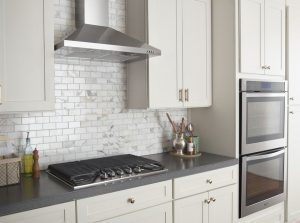1. The Blower
The blower is the internal motor that powers airflow for your range hood. Unfortunately, many decorative range hoods do not automatically come with one. The reason for this is that the blower needs to have the appropriate power level for your stove. So, now is the time to verify that the appropriate blower has been ordered for your new range hood.
There are three basic categories of blower:
Internal: This is housed inside the hood, which offers the most power, but it can be louder.
External: This is placed outside the house or installed on the roof, but because it is further from your cook surface, it is less powerful. While it is less noisy in your kitchen, it needs to be correctly set up for winter or cold air may seep into your home.
Inline: This involves a blower positioned in a crawl space or attic. This type of blower installation is not generally recommended as it is difficult to install and service.
2. Venting
If you’re replacing an existing hood, you may not know whether you have horizontal or vertical venting, but your new hood needs to be compatible. So, it is important that you double check the type of venting in your home and whether your new hood can accommodate it.
You also need to check that your ductwork is ready for the installation. While your retailer may offer a delivery and installation service, this is only possible if the ductwork has already been installed by a licensed HVAC professional. Your contractor can also ensure that the proper connections have been installed and are ready for appliance installation.
3. The Distance Between Cook Surface and Range Hood
Another important consideration for your range hood installation is the distance between the cook surface and range hood. This is a fine balance, as it needs to be close enough to suck up any steam and odors, but not so low that it is damaged by heat or you bang your head.
A good rule of thumb is for the range hood to hang 32 to 36 inches over your cook surface for gas. However, if you have an induction or electric cooktop, the heat is directly transferred to the pot so they don’t need to be as far away. If in doubt, check the specifications on your specific hood range model for height recommendations.
4. Hood Inserts
If you have ordered a decorative or custom built range hood cover, you will need an insert that fits into the opening. If you’ve opted for this type of cover, you’ll need to confirm with your cabinet maker and appliance salesperson to ensure that everything will match up.
4. The Electrical Connections
Finally, you also need to ensure that all the necessary electrical connections are in place. The blower and lighting on your range hood need a connection to electricity to function. So, there needs to be connections that are accessible and in a serviceable location. Your model of range hood may require a direct wire or an outlet, so you will need to check which one is required for your installation.
If you’re planning on a new range hood, you can rely on the expertise of a professional appliance repair and installation specialist. Your technician can discuss any concerns you may have, so you’re happy with the final installation.
